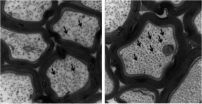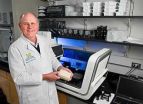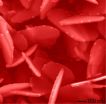(Press-News.org) PHILADELPHIA – Finding a drug that can cross the blood-brain barrier is the bane of drug development for Alzheimer's disease and other neurological disorders of the brain. A new Penn study, published this week in the Journal of Neuroscience, has found and tested in an animal model of Alzheimer's disease a class of drug that is able to enter the brain, where it stabilizes degenerating neurons and improves memory and learning.
In the normal brain, the protein tau plays an important role in stabilizing structures called microtubules in nerve cells, which serve as tracks upon which cellular material is transported. In Alzheimer's disease and related disorders, tau becomes insoluble and forms clumps in the brain. One consequence of these aggregates is a depletion of normal tau, resulting in destabilization of the microtubule tracks that are critical for proper nerve-cell function.
Senior authors Virginia M.-Y. Lee, PhD, director of the Center for Neurodegenerative Disease Research (CNDR), and John Trojanowski, MD, PhD, director of the Institute on Aging and CNDR co-director, introduced the concept of using microtubule-stabilizing drugs over 15 years ago to counteract tangles of tau and compensate for the loss of normal tau function. Kurt Brunden, PhD, director of Drug Discovery at CNDR and Bin Zhang, MD, PhD, senior research investigator, are the first authors on this study from the University of Pennsylvania School of Medicineand the School of Arts and Sciences.
In 2005, the CNDR researchers showed that the anti-cancer drug paclitaxel (Taxol™) could improve spinal cord nerve function in mice with tau tangles in their brains, after the drug was absorbed at nerve termini in muscle. "However, paclitaxel and related drugs do not cross the blood-brain barrier" notes Brunden. "So we surveyed a number of additional microtubule-stabilizing agents and discovered that the epothilone class, and in particular epothilone D, readily entered and persisted in the brain."
"The positive effect of epothilone D on the function of axons and on cognition, without the onset of side-effects offers hope that this class of microtubule-stabilizing drugs could progress to testing in Alzheimer patients in the near future," says Lee.
"There are very few tau-focused drugs in clinical trials now for Alzheimer's disease," says Trojanowski. "While we and others have urged that pharmaceutical companies should not put all of their eggs in one drug basket to ensure the highest likelihood of finding disease-modifying therapies for Alzheimer's, we hope this successful mouse study of a tau drug will encourage more pharmaceutical companies to pursue programs on tau-focused drug discovery."
Help from Sponges
The epothilones are microtubule-binding drugs derived from marine sponges and have been used as anti-cancer drugs because they prevent cells from dividing. They do this by keeping microtubules overly stabilized, which blocks cell division and causes cell death in rapidly dividing cells such as cancer cells. However, since nerve cells do not replicate or divide, they are immune to the toxic effects of microtubule-binding drugs.
In Alzheimer's disease and other diseases with tau clumps in the brain, the hope is that a microtubule-stabilizing drug will restore the microtubule tracks to their original supportive structure. This led the researchers to give the tau mice epothilone D (epoD) to replace the now unavailable tau.
Indeed, epothilone D improved the brain function of tau mice, which have tau inclusions in their forebrain, degenerated axons, and broken microtubules. After treating three-month old male tau mice with a low dose of epoD once a week for three months, the mice showed increased numbers of microtubules and improved axon integrity, without notable side effects to organs and immune cells.
What's more, epothilone D reduced deficits in memory and learning in the tau mice. "EpoD improves cognition in mice affected by neurodegenerative tau pathology. These findings suggest that epothilone D and other microtubule-stabilizing agents hold considerable promise as potential treatments for neurodegenerative diseases in humans," says senior author Amos B. Smith III, PhD, the Rhodes Thompson Professor of Chemistry.
INFORMATION:
This research was funded by the National Institute on Aging and the Marian S. Ware Alzheimer Program.
Penn Medicine is one of the world's leading academic medical centers, dedicated to the related missions of medical education, biomedical research, and excellence in patient care. Penn Medicine consists of the University of Pennsylvania School of Medicine (founded in 1765 as the nation's first medical school) and the University of Pennsylvania Health System, which together form a $3.6 billion enterprise.
Penn's School of Medicine is currently ranked #2 in U.S. News & World Report's survey of research-oriented medical schools, and is consistently among the nation's top recipients of funding from the National Institutes of Health, with $367.2 million awarded in the 2008 fiscal year.
Penn Medicine's patient care facilities include:
The Hospital of the University of Pennsylvania – the nation's first teaching hospital, recognized as one of the nation's top 10 hospitals by U.S. News & World Report.
Penn Presbyterian Medical Center – named one of the top 100 hospitals for cardiovascular care by Thomson Reuters for six years.
Pennsylvania Hospital – the nation's first hospital, founded in 1751, nationally recognized for excellence in orthopaedics, obstetrics & gynecology, and psychiatry & behavioral health.
Additional patient care facilities and services include Penn Medicine at Rittenhouse, a Philadelphia campus offering inpatient rehabilitation and outpatient care in many specialties; as well as a primary care provider network; a faculty practice plan; home care and hospice services; and several multispecialty outpatient facilities across the Philadelphia region.
Penn Medicine is committed to improving lives and health through a variety of community-based programs and activities. In fiscal year 2009, Penn Medicine provided $733.5 million to benefit our community.
Penn study gives hope for new class of Alzheimer's disease drugs
2010-10-19
ELSE PRESS RELEASES FROM THIS DATE:
ORNL theorist part of team that discovers unexpected magnetism
2010-10-19
OAK RIDGE, Tenn., Oct. 18, 2010 -- Theoretical work done at the Department of Energy's Oak Ridge National Laboratory has provided a key to understanding an unexpected magnetism between two dissimilar materials.
The results, published in Nature Communications, have special significance for the design of future electronic devices for computations and telecommunications, according to co-author Satoshi Okamoto of ORNL's Materials Science and Technology Division. The work was performed at Universidad Complutense de Madrid, synchrotron radiation facilities in France and Japan, ...
Four new psoriasis 'hotspots' identified by U-M geneticists
2010-10-19
ANN ARBOR, Mich. — Scientists at the University of Michigan Heath System and their collaborators have found four new DNA "hotspots" that may one day help guide new treatments for psoriasis, one of the most common autoimmune diseases in the country.
Using cutting-edge methods to peer into the hidden genetic underpinnings of the disabling and disfiguring disease, the research, published in Nature Genetics, further maps the as-yet unknown territories of psoriasis and psoriatic arthritis.
The findings could lead to new drug targets and tailored treatments for the skin ...
Japanese researchers report on liver transplantation studies using animal and iPS cells
2010-10-19
Tampa, Fla. (October 18, 2010) –Two research teams from the Okayama University Graduate School of Medicine (Okayama, Japan) have reported breakthrough studies in liver cell transplantation. One team found that the technical breakthrough in creating induced pluripotent stem cells (iPS) from mouse somatic cells (nonsex cells) in vitro had "implications for overcoming immunological rejection." Whereas a second team using liver cell xenotransplantation - transplanting cells of one species into another (in this case transplanting pig liver cells into mice) - found that transplanted ...
Vitamin D deficiency linked to lung transplant rejection
2010-10-19
MAYWOOD, Ill. -- Vitamin D deficiency is associated with a significant increase in lung transplant rejection, according to research conducted at Loyola University Health System (LUHS). These data were presented Monday at The American Society for Bone and Mineral Research 2010 annual meeting in Toronto, Ontario.
"Vitamin D deficiency is prevalent among lung transplant recipients," said Pauline Camacho, MD, study investigator and director of the Loyola University Osteoporosis and Metabolic Bone Disease Center. "This study shed greater light on the serious impact that this ...
Does clenching your muscles increase willpower?
2010-10-19
The next time you feel your willpower slipping as you pass that mouth-watering dessert case, tighten your muscles. A new study in the Journal of Consumer Research says firming muscles can shore up self-control.
Authors Iris W. Hung (National University of Singapore) and Aparna A. Labroo (University of Chicago) put study participants through a range of self-control dilemmas that involved accepting immediate pain for long-term gain. In one study, participants submerged their hands in an ice bucket to demonstrate pain resistance. In another, participants consumed a healthy ...
Breakthrough in nanocrystals growth
2010-10-19
Argonne, ILL—For the first time scientists have been able to watch nanoparticles grow from the earliest stages of their formation. Nanoparticles are the foundation of nanotechnology and their performance depends on their structure, composition, and size. Researchers will now be able to develop ways to control conditions under which they are grown. The breakthrough will affect a wide range of applications including solar-cell technology and chemical and biological sensors. The research is published in NANOLetters.
As coauthor Wenge Yang of the Carnegie Institution's ...
How do beauty product ads affect consumer self esteem and purchasing?
2010-10-19
A new study in the Journal of Consumer Research found that ads featuring beauty products actually lower female consumers' self-esteem.
"One of the signature strengths of the advertising industry lies in its ability to transform seemingly mundane objects into highly desirable products," write authors Debra Trampe (University of Groningen, the Netherlands), Diederik A. Stapel (Tilburg University), and Frans W. Siero (University of Groningen). In an advertisement, a lipstick situated next to a stiletto heel represents glamour and a teddy bear in an ad for fabric softener ...
Is team science productive?
2010-10-19
PHILADELPHIA - Taking a cue from the world of business-performance experts and baseball talent scouts, Penn Medicine translational medicine researchers are among the first to find a way to measure the productivity of collaborations in a young, emerging institute. They published their findings the most recent issue of Science Translational Medicine.
While metrics exist to measure the contributions of individual scientists, judging the effectiveness of team science has been more challenging. Reasoning that team science produces papers and grants, first author postdoctoral ...
Benign envy sells iPhones, but malicious envy drives consumers to BlackBerries
2010-10-19
People are willing to pay more for products that elicit their envy—but that's only when they are motivated by a positive, benign form of envy, according to a new study in the Journal of Consumer Research.
"Our studies showed that people who had been made envious of someone who owned an iPhone were willing to pay 80 Euros more on average," write authors Niels van de Ven, Marcel Zeelenberg, and Rik Pieters (Tilburg University).
The researchers made some important discoveries about the motivations that result from different kinds of envy. "Note that two types of envy exist: ...
Diabetic adults' conditions improved after phone calls with fellow patients
2010-10-19
The findings, published Oct. 19 in the Annals of Internal Medicine, showed the peer partner program resulted in lower glycated hemoglobin (HbA1c) levels after six months among men with uncontrolled diabetes.
The research was based on a peer partnership program established by the Veterans Affairs Ann Arbor Health System and the University of Michigan Medical School.
Each peer pair received initial brief training in peer communication skills and was expected to communicate by telephone at least once a week about their mutual efforts to improve diabetes control. Program ...



